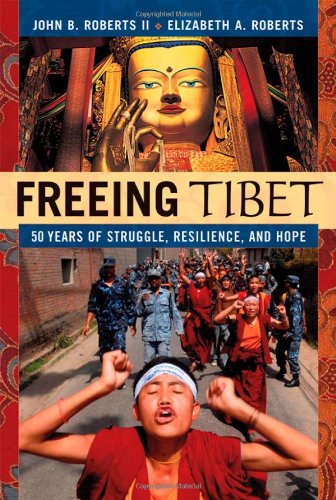Product desciption
Freeing Tibet 50 Years Of Struggle Resilience And Hope John B Roberts Ii by John B. Roberts Ii, Elizabeth A. Roberts 9780814409831, 0814409830 instant download after payment.
Credit Allen Ginsberg! His Beat quest crossed, in New Jersey, with Geshe Wangyal's Kalmyk refugees who founded the first Tibetan Buddhist monastery in a garage. While Ginsberg's popularization of the dharma, repeated in this book, is well-known, Wangyal and his Tibetan colleagues provide the other side of a symbiotic relationship between the counterculture and the Establishment in their struggle to raise not only consciousness but funds and resistance within the occupied homeland for the cause of freedom. The CIA, as the first part documents (within limits as much remains classified), tried to work within Cold War tensions, India-China frontier clashes, and propaganda benign and black to support Khampa freedom fighters in the Eisenhower administration. But, after secret guerrilla training in Saipan and Colorado, and airlifts into Tibet, the People's Liberation Army, in 1961, slaughtered the rebels in a "second Bay of Pigs" that today still is largely hush-hush, even to the Beltway-insider authors, who in this narrative rely on CIA operatives and released security directives to explain the role of spies and arms in the failed first stage for Tibet's struggle against Communism. With the Asian geopolitical tensions rising in the early '60s, Tibet was abandoned by Washington. Part Two shows how Beats and then hippies-- and Ginsberg seems to be always in the vanguard-- took over the "ethical obligation" to Tibet. It concludes with an intriguing reflection. After the CIA's failure to support a popular uprising against vicious PLA reprisals, "shared spiritual values instead of political expendience" entered the awareness of the West. Therefore, "what appeared as a double-cross by the American government-- cold-hearted reneging on solemn promises to support the Dalai Lama during his exile-- was in reality a criss-cross, a moment in time when the surging counterculture took over from an establishment that had discarded the goal of Tibetan liberation." (173) Published in 2008 after the latest uprising, Part Three therefore shows the little we know, given Chinese manipulation and censorship-- of the protests that March, that failed to derail international acclaim for the Beijing Olympics, and that did not result in Western leaders having the courage to boycott the most favored of all trading partners. Yet, the Roberts pair insist that, as with apartheid-era South Africa, divestment and boycotts can and would work against China to force a sort of Catalan autonomy within Spain parallel for Tibet. Their proposals, on economic, moral, and environmental grounds, dovetail nicely with the book also from 2008 by an advocate they both quote often, Robert Thurman in his "Why the Dalai Lama Matters." What frightens one in the last stages of the Roberts book is that the present, aging Dalai Lama may not reincarnate, or that his reincarnation may be stage-managed as the Panchen Lama has by the Chinese. The steady erosion of Tibetan culture, where 8 monasteries out of 6000 survived intact after the invasion and then the Cultural Revolution, continues. Native tour guides in Lhasa are replaced by Han Chinese parroting the party line of a grateful nation happy to be released from serfdom and pits of scorpions run by mad monks. The rail brings in immigrants; Tibetan is not taught but Chinese remains a must for traders and advancement of the dwindling indigenous population against the incomers who bring capitalism without ethics or respect for the Buddhist and local traditions. While this efficient account moves smoothly through such details, it stumbles a bit in the early section, perhaps burdened inevitably by lots of diplomatic minutiae that historians and analysts will nonetheless welcome. The second part, with the Beats and hippies, moves more fluidly; the third part weighs one down with the realization that cheap labor and high profits from the PRC trump any committment by the East or West to lasting Chinese reform. I'd have added a couple of clarifications. The 1904 British occupation of Lhasa by Col. Younghusband did lead to a treaty that forced Tibet's trade with the British in exchange for the Empire's recognition of its independence, but it also meant that the Chinese could twist this treaty with a foreign power into a reason to take over Tibet. The Manchus were deposed but the new Republic of China never ratified the Simla Conference of 1913-14 that acknowledged Tibetan independence. This issue is not mentioned by the Roberts, who maybe march too rapidly over early 20th century diplomatic foundations upon which the present Chinese later justified their long domination of Tibet. Also, in the Dorje Shukden controversy, the "rival sect" possibly entangled with the murderous debate over the 17th Karmapa seems worthy of more coverage. The Roberts do not elaborate, but the controversy over the New Kadampa Tradition (NKT) in the West that has spread an anti-Dalai Lama campaign taken up often by pro-PRC media appears deserving of attention, as this plays into the current political and cultural skirmishes over the Dalai Lama and his role in governing Tibetan affairs from his Dharamsala exile. Still, these are minor asides compared to the moral necessity that most in East and West have shirked-- outside of a few celebrities, musicians, more low-key activists, and brave protesters. Our leaders tell us to trust in "blind faith that capitalism has some magical quality to transform China from a one-party communist state to a multi-party democracy." (246) We buy cheap goods, we send them our factories, and we rely on them to support our debt. But, we fail to make them a fairer regime for the Han let alone Tibetans. I hope this book finds an audience, and I hope it changes the complacency and indifference with which many dismiss Tibet today.


